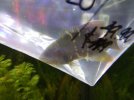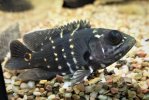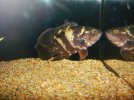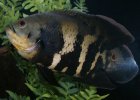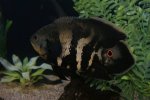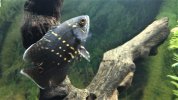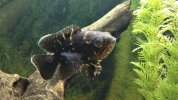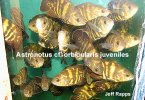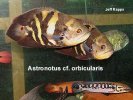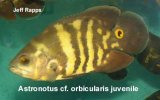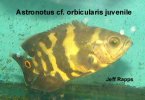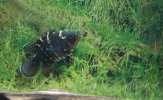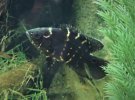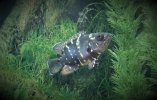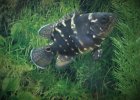So this is not my time with a "Bumblebee Oscar" I had one from Rapps TUIC some years back. Here are some reference pics from back then.
Typical Oscar behavior, newly introduced to tank and went to bottom and "pouted", lol
View attachment 10125
Grew up to look like this
View attachment 10126
View attachment 10127
There was some discussions on another site between myself and another person who has this same Oscar from Rapps at the same time.
Thought it was interesting what Kevin (new owner) from TUIC had to say about the fish, then and now ideas, so I quoted it and posted it here for any interested in the subject.
"an admin asked me to check out this topic and asked if I would please comment on the 'bumblebee' oscar.
so here you are

The real 'bumblebee oscar' is Astronotus crassipinnis. Yes, Astronotus cf. obicularis used to be marketed as the bumblebee. At the time these were being distributed then that was the accepted species name and bumblebee was the hobby name that was associated with. However, because of science.. obicularis has since that time become an invalid species. A. obicularis was redescribed as A. crassipinnis. so obicularis IS crasspinnis. Same fish. Reallyu not much else to say on that. That is what it is.
While on the topic of oscars. Astronotus rubrocellatus is also no longer a valid species as they too have be reassigned and are the same fish as Astronotus ocellatus.
At this time(and its been so for some time now) only two species of oscar exist. A. ocellatus and A. crassipinnis. Aside from some minor geographical population subtleties each is fairly easy to tell one from the other. Especially when you've handled literally thousands of each species of all sizes.
Along with taking over TUIC I also took all of the rights to the 30,000+ photos Jeff had documented of every species he ever imported over 30 years. SO I have hundreds of oscar photos with locations to browse through. I havent seen anything that jumps out as "hey thats different" or at least different enough to be something entirely new or different and get me excited enough to want to go through the trouble and thousands of dollars to get a specific one in. ocellatus look like ocellatus and crassipinnis look like crassipinnis with maybe some minor color differences or a few extra or a few less spots. In 2019 I was gifted a group of massive wild crassipinnis that were Jeffs original breeding group. They were giant and very, very old. I ended up selling the group in late 2020. they looked and were no different than the current stock. he had gotten them in and marketed them way back as Astronotus obicularis rio araguaia which is now Astronotus crassipinnis rio araguaia. same fish, same river, same exporter only a decade later we had science change the name.
As far as my bumblebees being different... not very likely as they are the same fish from the same source from the same river. Juveniles however, look significantly different from adults. So when comparing my juveniles to an adult yes, they look different. my larger ones look like all other bumblebees as they should because, well.. its the same fish..
ALL, yes I said ALL of the wild crasspinnis currently being exported out of Brazil come from 1 source.
like human sibling or other relatives.. some are good looking some are uglier lol.. same with fish even within the same population. once in a private aquarium environment. care, conditions, food, all come onto play as to the appearance of the fish."

